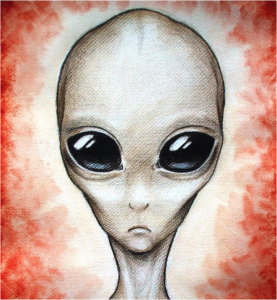 It is alleged that several species of extraterrestrial origin have visited our planet in the past or continue to visit today; and, in some conspiracy claptrap, are walking amongst us in disguise, are collaborating with select government factions, and have even created a human-extraterrestrial hybrid to gradually populate earth with their species. Why they are here, if that is the case, is beyond the scope of this book–for our purpose is only to investigate whether or not they can exist.
It is alleged that several species of extraterrestrial origin have visited our planet in the past or continue to visit today; and, in some conspiracy claptrap, are walking amongst us in disguise, are collaborating with select government factions, and have even created a human-extraterrestrial hybrid to gradually populate earth with their species. Why they are here, if that is the case, is beyond the scope of this book–for our purpose is only to investigate whether or not they can exist.
Author: Director
Army Officer Turned Ufologist Antonio Paris Chases Aliens With Reasonable Doubt
In our X-Files reboot world, it’s hard to take ufology, the study of UFOs, seriously. The problem, at its core, is less scientific than sociological. The community that believes in the proximity of extraterrestrial life has long had a fraught relationship with logic and reason. Antonio Paris’s job is to bridge the divide between those who want to believe and those who demand proof. As the head ofAerial Phenomena Investigations, Paris has spent the last five years working with a former NASA engineer and a journalist to uncover both evidence and its absence. Paris, a former U.S. Army intelligence officer, also works as anastronomer at St. Petersburg College in Florida. He spends a lot of time looking up, but even more time looking around.
It bears saying — precisely because it doesn’t go without saying — that Paris is not a crank. In a sense, he’s exactly the opposite. He exhibits the rare ability to keep belief close and doubt closer. It is this trait, coupled with the thoroughness of his work, that has enamored him to the scientific community, which embraces him with open arms. Paris spoke with Inverse about dueling with investigative and scientific pistols at a time when most other Ufologists are stuck on Area 51.
Four Years of UFO Investigations – What We Learned
Facts are stubborn things; and whatever may be our wishes, our inclinations, or the dictates of our passions, they cannot alter the state of facts and evidence. — John Adams, 1770
Four Years of UFO Investigations – What We Learned:
An unidentified flying object (UFO), in its strictest sense, is an unfamiliar anomaly in the sky that is not readily identifiable to the observer as any known object. Technically, “UFO” refers to something that cannot be identified; unfortunately, in contemporary popular culture, the term has become synonymous with extraterrestrial spacecraft. However, decades of investigations, research, and analysis from a cadre of UFO investigators, including the United States Air Force, have established that most UFO sightings are either hoaxes or misidentifications of man-made terrestrial objects and natural phenomena. Evidence of extraterrestrial life remains elusive as ever.
The lack of physical and scientific proof beyond a reasonable doubt has pushed UFOs to be regarded along with Bigfoot, the Loch Ness Monster, the chupacabra, and leprechauns: subjects nestled together in the occult section of your local bookstore or library. This unfortunate occurrence, in my opinion, is a direct result of a once-worthy subject being hijacked by a convergence of armchair UFO investigators, conspiracy theorists, hoaxers, and people taking occasional cheesy photos of alleged extraterrestrials or flying saucers.
UK Photo Likely a Lensflare
On 06 March 2015, UFO investigators from the United Kingdom forwarded a photo of an alleged UFO. According the investigators, the photo was taken in Plymouth, UK, in January 2012. A thorough analysis by Aerial Phenomena concluded the photo was nothing more than a traditional lens flare. The investigation was closed as resolved.
14-077-FB1-Phoenix
Remain Anonymous: No
Field Investigation Requested: yes
Date of Sighting: 07/11/2014
Time of Sighting: 5 pm
Duration of Event: approx 30 minutes
Location of UFO: Phoenix Arizona USA near Granada Park
Shape of Object: Saucer
Case Closed as Man-made Object.
Final Report: 14-077-FB1-Phoenix (Antonio)
API Case Files are back!
Ufology Today
Ufology is not a Science: Science is a systematic enterprise that constructs and organizes knowledge in the form of testable explanations and predictions about the universe. Ufology, however, is not a science, and no research on or investigation of UFOs has provided a testable explanation and prediction. Nevertheless, there is a growing trend in the UFO community to present ufology as a science and a topic that requires urgent response from the government. Many mainstream ufologists as well as speakers at UFO conferences attempt to use fancy words such as quantum mechanics, which should immediately be considered a red flag. Most ufologists are not scientists and are simply invoking a poorly understood branch of science. Quantum mechanics is the science that deals with matter at the level of atomic and subatomic particles; thus, it cannot be applied to the macroscopic world of large physical objects such as UFOs.
API to Host Another Google Hangout!
Due to popular request, API will host another LIVE Google Hangout in early December. The date will be posted no later than 15 Oct 2014!
Plausible Origin of the Grays
While reports of the Grays have circulated in the UFO and conspiracy-theory community for decades, their origin is often associated with the 1961 Betty and Barney Hill abduction claim.[i] Because the media began to report on the alleged creatures after the Hill claim, the UFO community has assumed that the Grays are a recent phenomenon. However, that is not the case. The first appearance of the Grays can be traced as far back as 1891, decades before the post-1947 UFO wave. Almost 125 years ago Kenneth Folingsby published a book titled Meda: A Tale of the Future.[ii] The book, which derived from the author’s visions of the future while in a coma, described “tiny gray men with heads shaped like hot air balloons.” Soon thereafter readers were fascinated by what the human species might look like after millions of years of evolution. In 1893 H. G. Wells wrote a short article titled “The Man of the Year Million” in which he speculated on that subject. Wells imagined human beings as having no hair, mouth, or nose, but they would have an enormous light-bulb-shaped head and a small body.
Wells also published The War of the Worlds in 1897. His representation of Martians in that novel, according to a biography, was a convergence of pure imagination and Wells’s research on evolution. He depicted Martians as having enlarged heads because they supposedly were a more intelligent race than humans. Furthermore, according to Wells, the Martians had large eyes, no nose or ears, and very small mouths. He also envisioned Martians as communicating telepathically with each other to eliminate all misunderstanding, a trait that remarkably has been reported by alleged abductees.
In the 1930s and 40s, once again before the UFO wave, little gray aliens were a staple feature of many comic books such as Amazing Stories, Wonder Stories, and Science Wonder Stories. During this era when comic books were having a large impact on society, many of the tales they published concerned gray “visitors from space.”
[i] Betty and Barney Hill. University of New Hampshire Library. http://www.library.unh.edu/special/index.php/betty-and-barney-hill.
[ii] “A Media History of Gray Aliens.” http://www.theironskeptic.com/articles/gray/gray_history.htm.
API Case Load Increases
We are in the process of updating our UFO database the first week of September 2014. This past summer we received dozens of reports, which will be uploaded to this website shortly. Stay tune!








